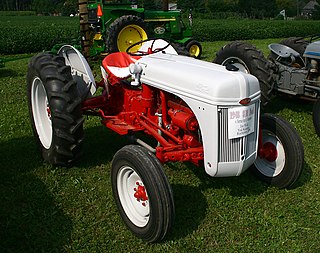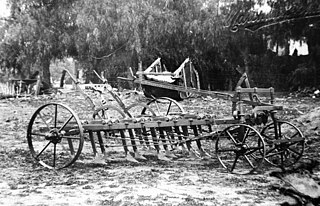The Petty Plough was a steerable plough developed by brothers Frank and Herbert Petty of Doncaster, Victoria, Australia in the early 1930s.
Contents

The Petty Plough was a steerable plough developed by brothers Frank and Herbert Petty of Doncaster, Victoria, Australia in the early 1930s.

Frank and Herbert Petty were orchardists, growing apples, pears, lemons, cherries and peaches. The entire orchard was cultivated. The Petty Plough was designed to plough between and around the fruit trees, working right up to the trees, eliminating the need for slow and tedious manual cultivation between the trees.
The Petty Plough could be pulled by two horses or by a tractor. [1]


The Plough was fitted with lever and foot controls which operated four straight disc wheels. These were turned in and out of the trees as the operator desired. The wheels would sink into the ground about 2.5 inches, giving good control and preventing side slipping often associated with ploughing uneven surfaces. The cutting discs were on an extended floating arm, which followed the land they were working. Depth was regulated by two levers and the discs could be reversed to turn soil towards or away from trees. [2] [3] Soil was turned towards the trees in autumn and away from the trees in spring. This facilitated drainage in the wetter months and conserved water in the dryer months. [1] The plough was manufactured in two types: light and heavy. The light weighed 7 cwt and the heavy 8 cwt 2 qrs.
It could be used as a single furrow, double furrow or triple furrow plough. The single furrow plough had one 23-inch diameter disc, the double furrow had one 23-inch disc and one 20-inch disc, while the triple furrow had three 23-inch discs.
"The Petty Orchard Disc Stripping Plough is the greatest labour saver of all time. It eliminates a lot of back-breaking work in cutting out the strips between trees. The operator is able to ride on the plow seat, thus sitting down and doing the job in comfort." [4]


Frank Petty probably conceived the idea for a steerable plough, although the source of his inspiration is unknown. He invented many useful objects for use on his orchard. He developed and marketed the 'Whirlpool Spray Mix' a device not unlike a giant eggbeater which clamped to the inside of a drum of fruit spray, with a handle which when turned was designed to mix the spray. [5]


On 10 October 1932, Frank made a 'Provisional Application' for a Plough and Cultivator. [6] This lapsed in 1933. [7]
It is thought that he asked his brother Herbert, who had greater mechanical skills, to assist him with the development of the plough. Another application dated 24 July 1933 was lodged in joint names. This resulted in an Australian Patent being advertised on 4 October 1934 and subsequently granted. [8] The plough was also patented in the United States of America.[ citation needed ]

Experimental versions of the plough went through several iterations. An early version involved the operator walking behind a device on which while all four wheels were steerable, the front and rear wheels turned together. The operator controlled the direction of the device by moving from side to side a long lever which projected tiller like from the rear of the device.
A subsequent prototype plough was constructed using the front axles from two T Model Fords. [1] All four wheels were steerable. Front and rear wheels turned independently of each other. The tyres were removed, and the plough ran on the rims of the wheels, which had wooden spokes. The main structural members of the plough were made from 4-inch hardwood, joined at each end by specially made steel strips bolted to the timber. The operator sat on the plough and steered using a series of levers and foot controls.
The prototype sat for many years unused and forlorn under a row of pine trees on Frank's property. It was destroyed in a grass fire in the late 1960s.
The ploughs were manufactured by Daniel Harvey, [9] a machinery maker located in Box Hill, a locality adjoining Doncaster under licence from Frank and Herbert Petty as the patent holders.

The plough was widely used in South Eastern Australia including Tasmania, Western Australia, New Zealand, New Guinea, and Germany. [1]
Changes in orchard management, specifically a change from cultivation (also referred to as tillage) to mowing, limited the usefulness of the plough from the 1960s onwards.

A plough or (US) plow is a farm tool for loosening or turning the soil before sowing seed or planting. Ploughs were traditionally drawn by oxen and horses but modern ploughs are drawn by tractors. A plough may have a wooden, iron or steel frame with a blade attached to cut and loosen the soil. It has been fundamental to farming for most of history. The earliest ploughs had no wheels; such a plough was known to the Romans as an aratrum. Celtic peoples first came to use wheeled ploughs in the Roman era.

Tillage is the agricultural preparation of soil by mechanical agitation of various types, such as digging, stirring, and overturning. Examples of human-powered tilling methods using hand tools include shoveling, picking, mattock work, hoeing, and raking. Examples of draft-animal-powered or mechanized work include ploughing, rototilling, rolling with cultipackers or other rollers, harrowing, and cultivating with cultivator shanks (teeth).

A tractor is an engineering vehicle specifically designed to deliver a high tractive effort at slow speeds, for the purposes of hauling a trailer or machinery such as that used in agriculture, mining or construction. Most commonly, the term is used to describe a farm vehicle that provides the power and traction to mechanize agricultural tasks, especially tillage, and now many more. Agricultural implements may be towed behind or mounted on the tractor, and the tractor may also provide a source of power if the implement is mechanised.

In agriculture, a harrow is a farm implement used for surface tillage. It is used after ploughing for breaking up and smoothing out the surface of the soil. The purpose of harrowing is to break up clods and to provide a soil structure, called tilth, that is suitable for planting seeds. Coarser harrowing may also be used to remove weeds and to cover seed after sowing.

A grader, also commonly referred to as a road grader, motor grader, or simply blade, is a form of heavy equipment with a long blade used to create a flat surface during grading. Although the earliest models were towed behind horses, and later tractors, most modern graders are self-propelled and thus technically "motor graders".

The M-94 was a piece of cryptographic equipment used by the United States Army, consisting of several lettered discs arranged as a cylinder. It was also employed by the US Navy, under the name CSP 488.

A skidder is any type of heavy vehicle used in a logging operation for pulling cut trees out of a forest in a process called "skidding", in which the logs are transported from the cutting site to a landing. There they are loaded onto trucks, and sent to the mill. One exception is that in the early days of logging, when distances from the timberline to the mill were shorter, the landing stage was omitted altogether, and the "skidder" would have been used as the main road vehicle, in place of the trucks, railroad, or flume. Modern forms of skidders can pull trees with a cable and winch, just like the old steam donkeys, or with a hydraulic grapple either on boom or on the back of the frame (clambunk skidder).

Ridge and furrow is an archaeological pattern of ridges and troughs created by a system of ploughing used in Europe during the Middle Ages, typical of the open-field system. It is also known as rigand furrow, mostly in the North East of England and in Scotland.

Dirtsurfing is the sport of riding a Dirtsurfer brand inline board. This new Australian boardsport is correctly known as inline boarding because Dirtsurfer is a trademark protected brand name.

A cultivator is a piece of agricultural equipment used for secondary tillage. One sense of the name refers to frames with teeth that pierce the soil as they are dragged through it linearly. Another sense of the name also refers to machines that use the rotary motion of disks or teeth to accomplish a similar result, such as a rotary tiller.

Curb feelers or curb finders are springs or wires installed on a vehicle that act as "whiskers" to alert drivers when they are at the right distance from the curb while parking.

Mallee are trees or shrubs, mainly certain species of eucalypts, which grow with multiple stems springing from an underground lignotuber, usually to a height of no more than 10 m (33 ft). The term is widely used for trees with this growth habit across southern Australia, in the states of Western Australia, South Australia, New South Wales and Victoria, and has given rise to other uses of the term, including the ecosystems where such trees predominate, specific geographic areas within some of the states and as part of various species' names.

Clarence Herbert Smith was an Australian agriculturalist, engineer, blacksmith and inventor.

John Fowler was an English agricultural engineer who was a pioneer in the use of steam engines for ploughing and digging drainage channels. His inventions significantly reduced the cost of ploughing farmland, and also enabled the drainage of previously uncultivated land in many parts of the world.
Roths Industries, Inc. (1945–1960) was a manufacturer of small garden tractors and other agricultural equipment founded by Herbert C. Roths in Alma, Michigan. The company manufactured Garden King Walking Tractors, BesRo Riding Tractors, and Till Ro Stalk Cutters.

The stump-jump plough, also known as stump-jumping plough, is a kind of plough invented in South Australia by Richard Bowyer Smith and Clarence Herbert Smith to solve the particular problem of preparing mallee lands for cultivation.

A quick release skewer is a mechanism for attaching a wheel to a bicycle. It consists of a rod threaded on one end and with a lever operated cam assembly on the other. The rod is inserted into the hollow axle of the wheel, a special nut is threaded on, and the lever is closed to tighten the cam and secure the wheel to the fork. Wheels equipped with quick release mechanisms can be removed from the bicycle frame and replaced without using tools by opening and closing the cam lever, thus more quickly than wheels with solid axles and nuts. On the negative side, a quick-release hub renders a wheel more vulnerable to theft and care must be taken to ensure that the mechanism is properly tightened.

Car controls are the components in automobiles and other powered road vehicles, such as trucks and buses, used for driving and parking.

The Farmall Regular, or just the Farmall, was the first in the Farmall line of general-use row-crop tractors manufactured by International Harvester. The Regular was the first affordable tractor that could be used for plowing, stationary threshing, or cultivating. For most of its product life it was marketed as the "Farmall," with the "Regular" added when the Farmall F-20 and F-30 appeared as its successors. More than 134,000 were sold from 1924 to 1931.